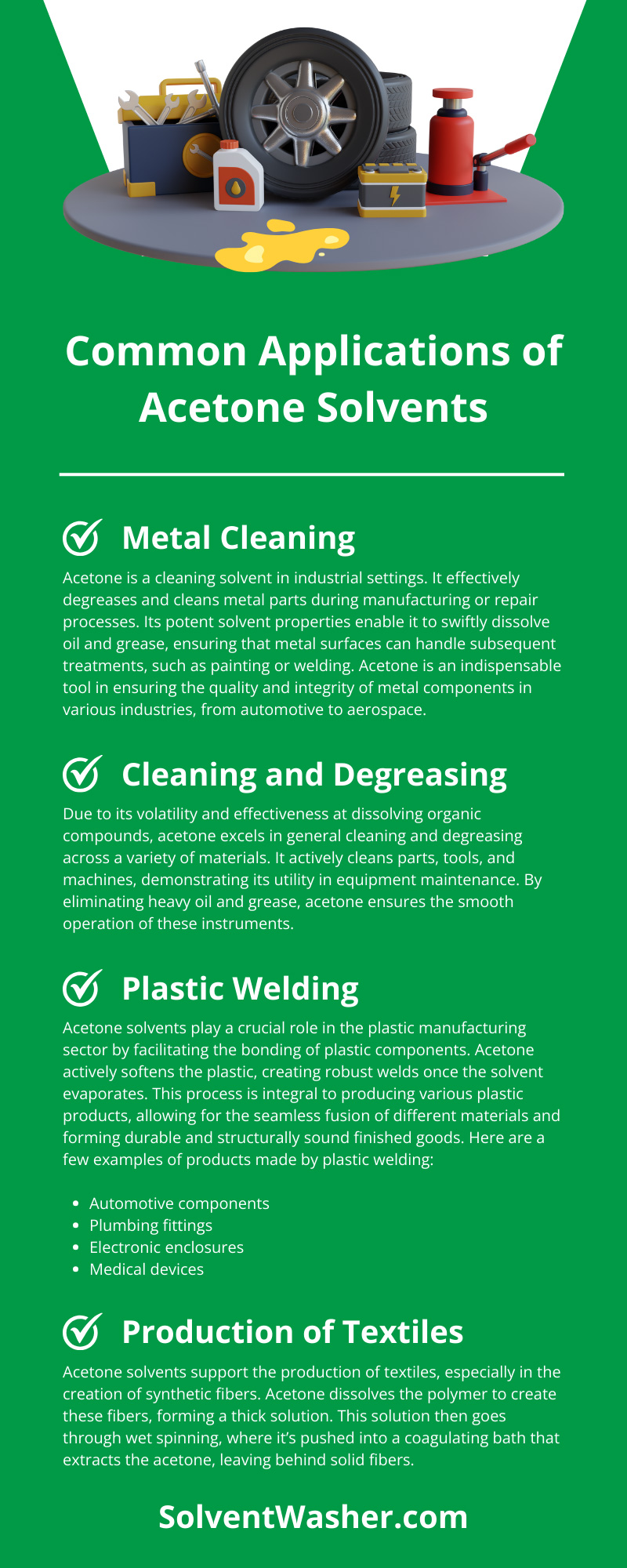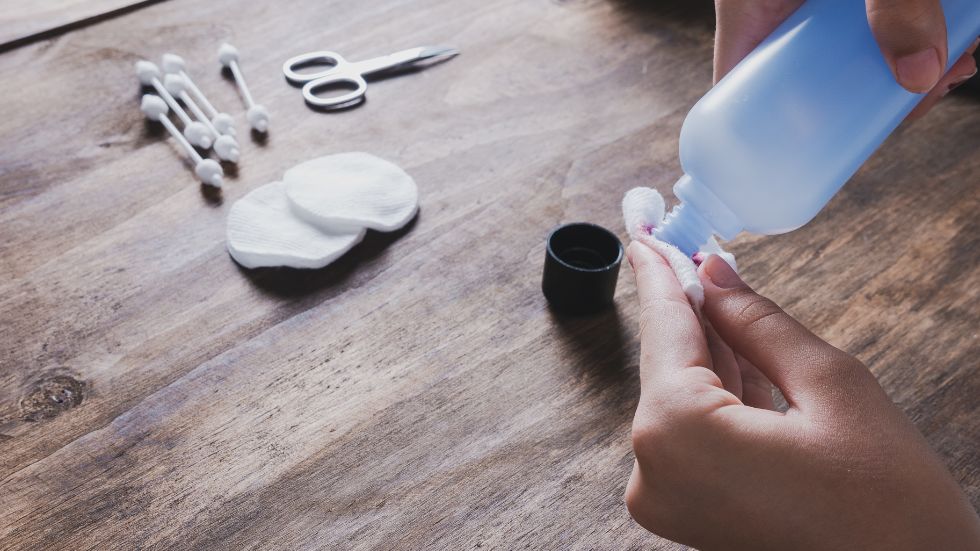Acetone is a powerful solvent known for its efficiency in various applications. Widely recognized for its use in everyday products such as nail polish remover, its versatility extends far beyond personal care. This guide highlights the common applications of acetone solvents while emphasizing safety precautions and addressing environmental considerations.
What Is Acetone?
Acetone, with the chemical formula C3H6O, is a colorless, highly volatile liquid known for its distinctive pungent, fruity odor. This versatile solvent exhibits high miscibility in water, ethanol, and other organic compounds, making it an essential component in various industrial processes and everyday products.
Due to its ability to dissolve substances, many people use it as an antiseptic. Acetone is produced through the oxidation of cumene or the dehydrogenation of isopropanol. You can find the solvent in nail polish removers, paint thinners, and as a key ingredient in producing plastics and synthetic fibers.
Its low freezing point of -94.7 degrees Celsius and boiling point of 56.53 degrees Celsius contribute to its widespread application as a solvent and chemical intermediate.
Metal Cleaning
Acetone is a cleaning solvent in industrial settings. It effectively degreases and cleans metal parts during manufacturing or repair processes. Its potent solvent properties enable it to swiftly dissolve oil and grease, ensuring that metal surfaces can handle subsequent treatments, such as painting or welding. Acetone is an indispensable tool in ensuring the quality and integrity of metal components in various industries, from automotive to aerospace.
Cleaning and Degreasing
Due to its volatility and effectiveness at dissolving organic compounds, acetone excels in general cleaning and degreasing across a variety of materials. It actively cleans parts, tools, and machines, demonstrating its utility in equipment maintenance. By eliminating heavy oil and grease, acetone ensures the smooth operation of these instruments.
Unlike some other degreasers, this potent solvent stands out for its ability to leave no residue behind. This feature makes it especially valuable in applications where a clean, film-free surface is essential, such as in automotive or industrial settings.
Plastic Welding
Acetone solvents play a crucial role in the plastic manufacturing sector by facilitating the bonding of plastic components. Acetone actively softens the plastic, creating robust welds once the solvent evaporates. This process is integral to producing various plastic products, allowing for the seamless fusion of different materials and forming durable and structurally sound finished goods. Here are a few examples of products made by plastic welding:
- Automotive components
- Plumbing fittings
- Electronic enclosures
- Medical devices
Production of Textiles
Acetone solvents support the production of textiles, especially in the creation of synthetic fibers. Consider the production of acrylic fibers, commonly found in apparel such as sweaters and fleece wear. Acetone dissolves the polymer to create these fibers, forming a thick solution. This solution then goes through wet spinning, where it’s pushed into a coagulating bath that extracts the acetone, leaving behind solid fibers.
Furthermore, acetone helps produce modacrylic fibers (which are common for faux fur and wigs). Acetone dissolves the polymer mix, and manufacturers spin the solution into fibers.
Moreover, acetone is a carrier for dye on synthetic fibers during the dyeing process, aiding in distributing the color evenly and ensuring vibrant, long-lasting results.
Nail Polish Remover
Nail polish remover is the most common application of acetone solvents. Acetone efficiently removes nail polish, making it a staple in salons and households. It effectively breaks down the chemical bonds in polish, efficiently removing the hardened polish from the nails. However, it can strip natural oils from the skin and nails. Due to its strong properties, it can also stain various surfaces, such as wood and fabric.
Hair and Skincare Products
Acetone is an effective cleansing and exfoliating agent in carefully measured concentrations. It can strip away excess oil and product build-up in hair, leaving the hair feeling clean and refreshed.
Similarly, acetone in skincare helps remove dead skin cells, promotes cell turnover, and reveals a brighter, more youthful complexion. However, due to their strength, it’s important to use these products with caution to avoid overdrying the skin or hair.
Laboratory Applications
In laboratory settings, acetone swiftly dissolves organic compounds without leaving residual substances, making it useful for cleaning glassware and preparing samples. Acetone can guarantee the absence of lingering contaminants in glassware, thus safeguarding the accuracy of experiments.
Additionally, in sample preparation for various analytical techniques such as chromatography, acetone’s thorough dissolution of compounds ensures the integrity of the analysis by preventing interference from residue or impurities.
However, it’s essential to handle acetone with care, considering its flammability and volatile nature, and to adhere to proper safety protocols when using it in laboratory environments.
Medical Uses
Acetone actively serves several medical applications, including skin peels and the preparation of medicinal creams and ointments. For instance, dermatologists use acetone with alcohol for acne treatments to perform chemical peels. Furthermore, pharmaceutical companies use acetone to dissolve active ingredients and fillers in the production of pills/tablets and liquid medication.
Paint Thinner
Acetone is an effective thinner because it reduces the thickness of the paint, making its application onto surfaces smoother and easier. For instance, when a painter wants to create a fine, even coat on a piece of furniture, they would use acetone to thin the paint. This process ensures that the paint spreads evenly, resulting in a flawless finish.
But acetone’s role continues beyond thinning paint. It also cleans brushes and equipment. People can soak them in acetone instead of dealing with dried brushes caked with hard paint. The solvent breaks down the paint residues, restoring the bristles to their original, soft state.
Similarly, acetone cleans painting equipment like spray guns and rollers. Removing any paint build-up prolongs the lifespan of these tools and maintains their performance.
Safety Precautions
When using acetone solvents, prioritize safety to protect health and prevent accidents.
- Ensure adequate ventilation.
- Wear suitable protective equipment like gloves and goggles.
- Keep away from heat and flames to avoid fire hazards.
- Avoid skin contact and ingestion, and always dispose of acetone properly, respecting environmental regulations.
Environmental Impact and Considerations
Industries and businesses heavily rely on acetone for various applications, yet its usage significantly affects the environment. As a volatile organic compound (VOC), acetone’s evaporation contributes to air pollution and smog formation. Moreover, if improperly disposed of, acetone can threaten aquatic ecosystems and water sources through contamination.
With these environmental concerns, industries should consider investing in acetone recycling systems to minimize the release of acetone into the environment. Additionally, improving disposal practices plays a crucial role in preventing the harmful effects of acetone on ecosystems and water quality.
Recognizing the need to address these challenges, proactive steps such as responsible usage, recycling, and proper disposal practices can reduce the environmental footprint of acetone utilization.
Final Thoughts
Acetone’s versatility and effectiveness underpin its wide array of applications across various industries. By adhering to safety guidelines and adopting eco-friendly practices, industries can harness the benefits of acetone solvents while minimizing environmental impacts.


